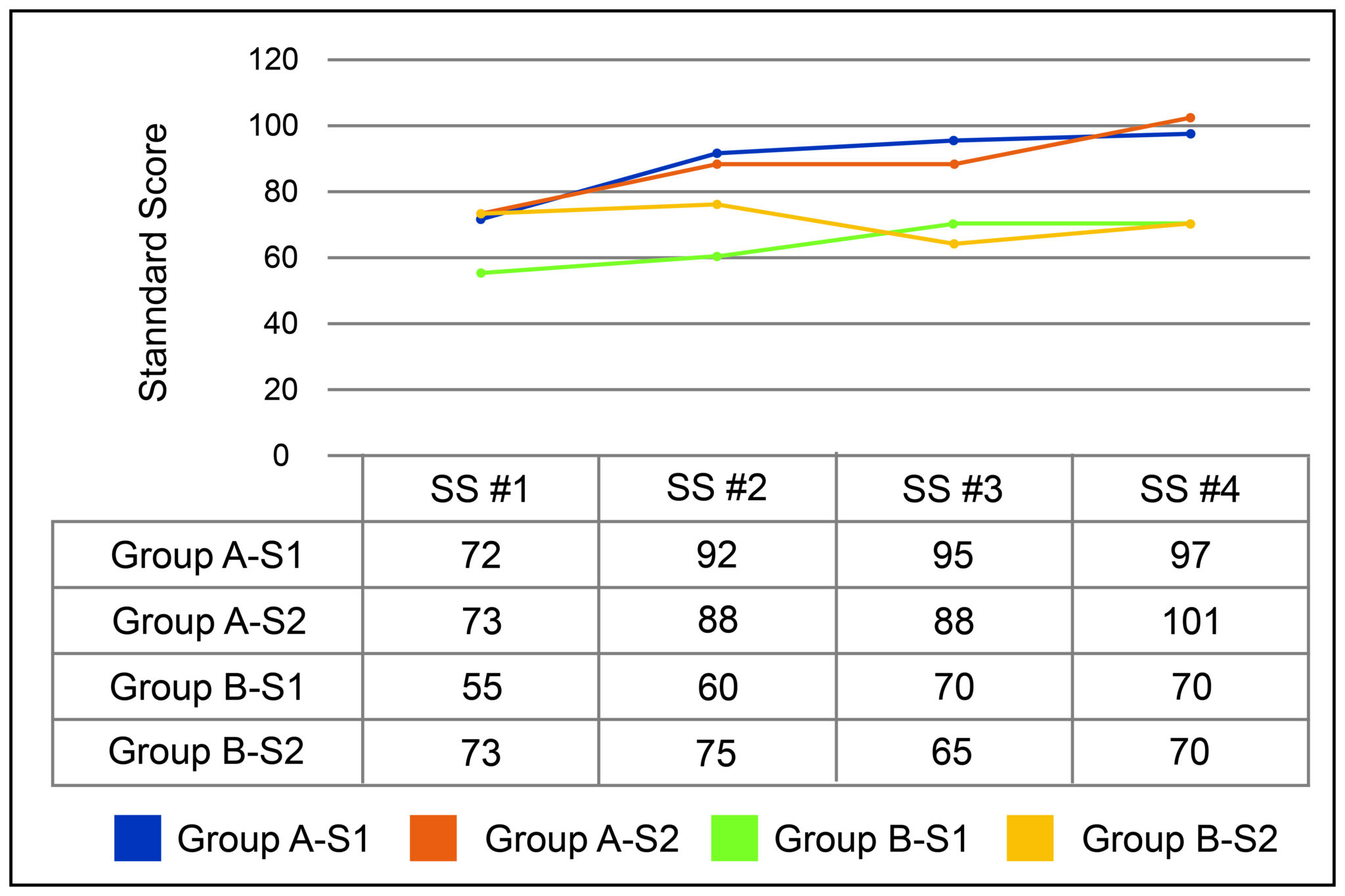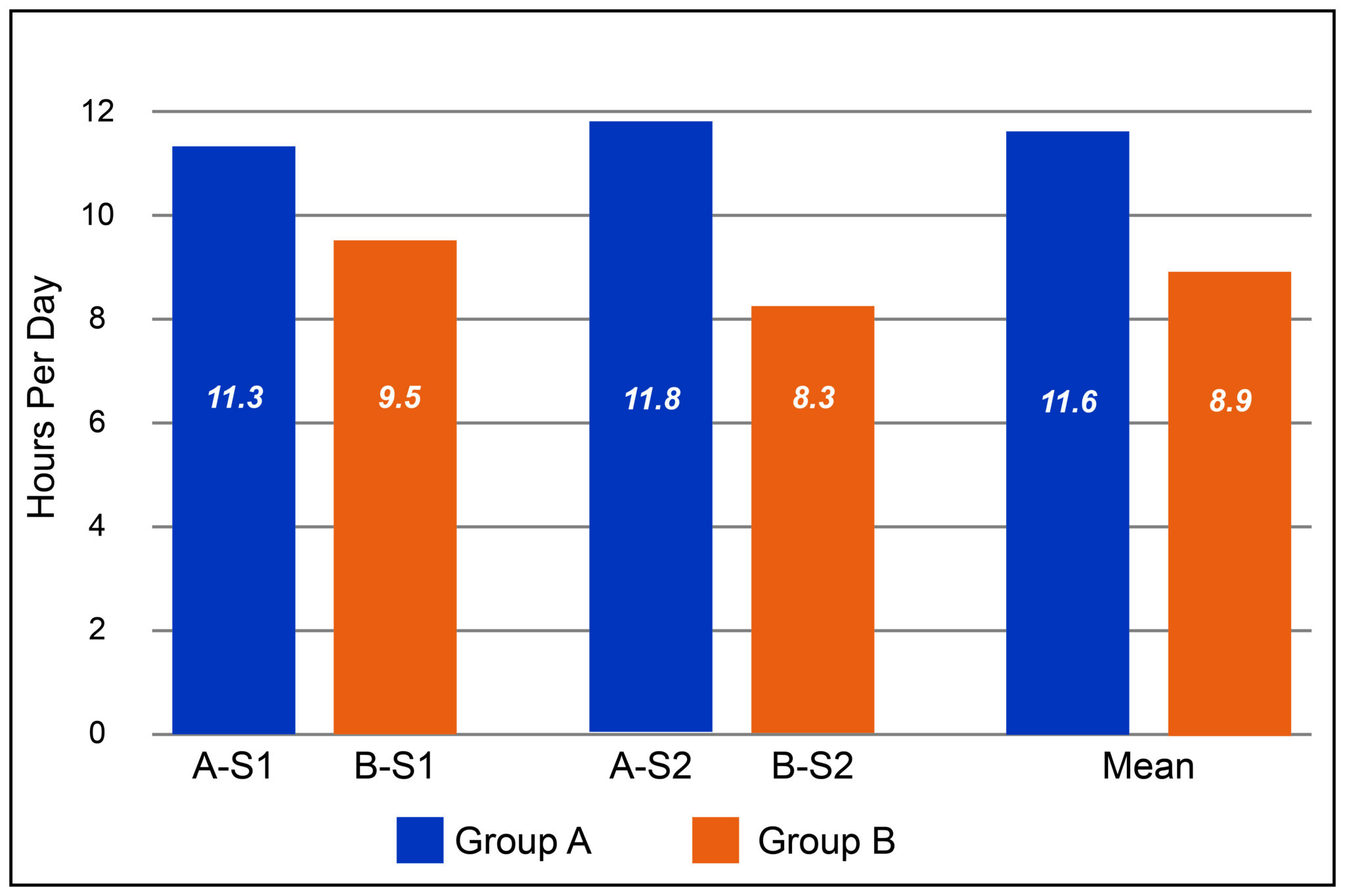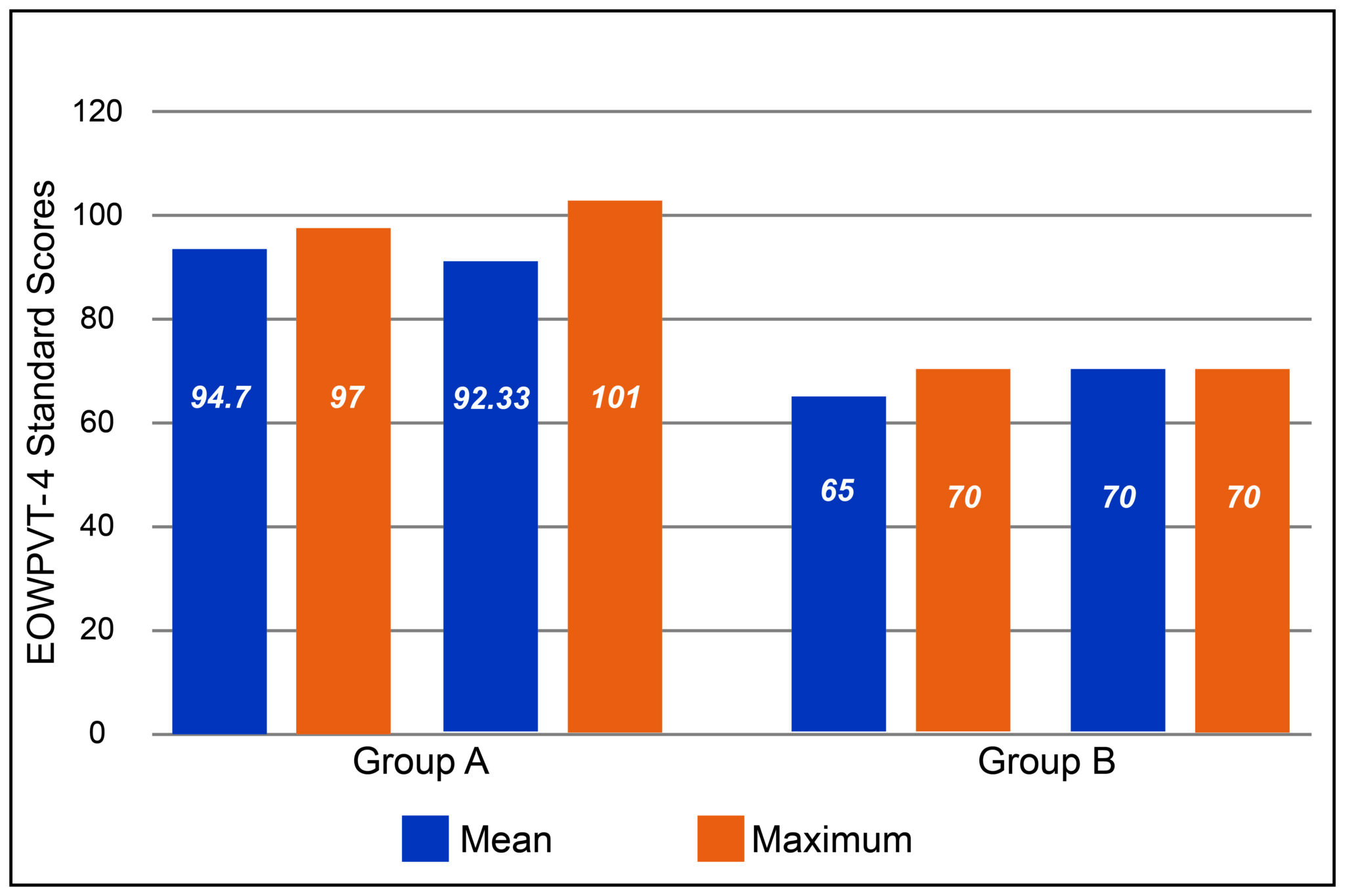Expressive Speech Intelligibility, Vocabulary, and Language in Children With Bilateral Cochlear Implants: A Retrospective Analysis of Device Use and its Influence on the Auditory Production Loop
by Deborrah Johnston, AuD, CCC-A, FAAA
OBJECTIVES AND METHODS
- Based on device use via data logging, two subject groups were selected:
- Group A (N=2) with device use averaging 11.6 hours per day
- Group B (N=2) with device use averaging 8.9 hours per day
- All subjects (mean age of activation was 1 year, 5 months) were implanted either simultaneously or sequentially with a short interval for the second side.
- Standard Scores on the Expressive One Word Picture Vocabulary Test (EOWPVT-4) were collected via record review over a four (4) year time interval.
- Datalogging via manufacturer software was obtained over multiple sessions.
- Final maximum Standard Scores were obtained prior to transition to regular education from an intensive educational setting focusing on Listening and Spoken Language (LSL).
INTRODUCTION
Research in the field of neuroplasticity has revealed that 90% of human brain development occurs in the first five years of life. For understanding speech through audition, the first three years are critical. For producing intelligible speech, the window of neural opportunity is the first five years of life. Access to the phonemes of speech is essential for the development of oral language. The influence of consistent device wear time for cochlear implant recipients during the early childhood years is explored in this retrospective case review. Data logging provides service providers the opportunity to monitor and improve this critical component, which influences both the development of speech perception and spoken language. Ensuring regular data logging of devices worn by children with cochlear implants is becoming a routine part of the post-implantation habilitative protocol.
EXPRESSIVE ONE WORD PICTURE VOCABULARY TEST (EOWPVT-4)

RESULTS
- Group A longitudinal mean = 93.5, maximum final mean = 99, well within one (1) standard deviation of the mean for age-matched, typically hearing peers
- Group B longitudinal mean = 67.5, maximum final mean = 70, representing two (2) SD’s below the mean for age-matched, typically hearing peers
- Group A data logging average was 30.3% higher than that of Group B
- Over four (4) years, Group A outperformed Group B by 38.%
- At transition, Group A outperformed Group B by 41.4
FUTURE RESEARCH
- Explore correlation of data logging with receptive and expressive language test measures, as a predictor of optimization and automaticity of the Auditory Production Loop.
- Validate a progress monitoring measure to assess the robustness of the developing APL, with provision for more aggressive LSL habilitation during the brain’s window of neural plasticity for listening and talking. This could be of critical impact for young children with cochlear implants who are not enrolled in specialized educational settings.
- Investigate whether graphic presentation of longitudinal test scores relative to device use may act as a motivator for parental support of consistent device use outside of educational and therapeutic environments.
CONCLUSIONS
- Suboptimal device wear time in the very early childhood years post-activation was associated with delayed and limited development of oral vocabulary, reflecting in weaker oral language skills and reduced Auditory Production Loop automaticity.
- Children with adequate daily device use made steady gains in their oral vocabulary scores, which was associated with improved oral language skills, optimal Auditory Production Loop, and improved preparedness for transition to non-specialized education.
- Early cochlear implantation and intensive listening and spoken language education and habilitation leads to improved oral language (vocabulary) outcomes, when associated with consistent device use. (“Eyes Open, Ears On”)
- Auditory Production (Feedback) Loop optimization and automaticity is likely correlated with more hours of device wear time with speech input and warrants further research.
DATA LOGGING

MEAN AND MAXIMUM SCORES

REFERENCES
Busch, T., Vermeulen, A., Langereis, M., Vanpoucke, F., van Wieringen, A. (2019) Cochlear Implant Data Logs Predict Children’s Receptive Language. Ear and Hearing. December, 2019 PAP.
Busch, T., Vanpoucke, F., vanWieringen, A. (2017) Auditory Environment Across the Life Span of Cochler implant Users: Insights from Data Logging. Journal of Speech, Language, and Hearing Research. 60: 1362-1377.
Caraway, T., Wolfe, J. (2019) Mission:Probable, Age-Appropriate Listening and Spoken Language Abilities for Children with Hearing Loss. Hearing First, LLC
Cristofari, E., Cuda, D., Martini, A., Forli, F., Zanetti, D., et all. (2017) A Multicenter Clinical Evaluation of Data Logging in Cochlear Implant Recipeints Using Automated Scene Classification Technologies. Audiology and Neurotology. 22: 226-235.
Easwar, V., Sanfilippo, J., Papsin, B., Gordon, K. (2018) Impact of Consistency in Daily Device Use on Speech Perception Abilities in Children with Cochlear Implants: Datalogging Evidence. Journal of the American Academy of Audiology. 29(9): 835-846.
Gagnon, EB, Eskridge, H, Brown, KD. (2019) Pediatric cochlear implant wear time and early language development. Cochlear Implants International. Sep29:1-6.
Ganek, HV, Cushing, SL, Papsin, BC. (2019) Cochlear Implant Use Remains Consistent Over Time in Children with Single-Sided Deafness. Ear and Hearing. Sep 19 PAP.
Guerzoni, L., Cuda, D. (2017) Speech processor data logging helps in predicting early linguistic outcomes in implanted children. International Journal of Pediatric Otorhinolaryngology. 101: 81-86.
Hanvey, K. DeBold, L. (2015) Preschool television programmes: Analysis using SmartSound IQ data logging. Cochlear Implants International. 16:sup 1: S26-S29.
Hey, M., Hocke, T., Ambrosch, P. (2018) Speech audiometry and data logging in CI patients: Implications for adequate test levels. HNO. 66 (Suppl 1): 22-27.
Rauch, A., Kagermann, S., Wesarg, T., Jakob, T., Aschendorff, A., Ihorst, G., Speck, I., Arndt, S. (2019) Data Logging Evidence of Cochlear Implant Use in Single-Sided and Bilateral Deafness. Audiology and Neurotology 24:206-216.
Ruffin, C., Kronenberger, W., Colson, B., Henning, S., Pisoni, D.(2013) Long-Term Speech and Language Outcomes in Prelingually Deaf Children, Adolescents and Young Adults Who Received Cochlear Implants in Childhood. Audiology and Neurotology. 18:289-296.
Wiseman, K., Warner-Czyz, A. (2018) Inconsistent device use in pediatric cochlear implant users: Prevalence and risk factors, Cochlear Implants International. 19:3: 131-141.

